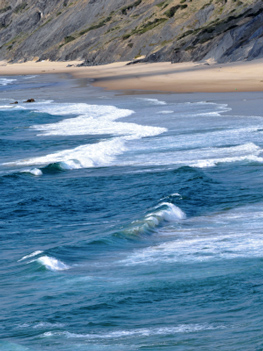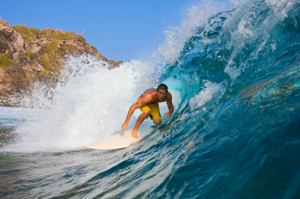How to Choose the Best Tides for Surfing
January 11, 2011

 “You should have been here an hour ago!”
“You should have been here an hour ago!”
This is one of the most deflating phrases you can hear from a fellow surfer. Becoming a student of tides can help ensure that you’ll be there when the waves are “going off” the next time.
The water depth at a break can greatly affect wave shape, size, and consistency. Choosing the best tide at which to surf is essential for amplifying the fun factor of your sessions. Do you often hear conflicting and confusing opinions on when that optimal tide window will be? You’re in luck. This guide will help make your tide selection decisions a little easier.
About Tides
The main tide affect is the lunar tide. It’s caused by the Moon’s gravity pulling on the Earth. However, the Sun also pulls on the Earth. So when the Sun and the Moon pull in the same direction, we see the highest high tides and the lowest low tides. In most places, the tide rises and falls twice a day, with the smallest fluctuations occurring near the equator.
It takes roughly six hours for rising water to hit high tide and another six or so to reach low tide again. This sequence is called the tidal cycle and repeats every 12 hours, 25 minutes. The tidal range is the amount of change in the water level during that cycle.
Choosing the Best Tide
There are several factors to consider when it comes to predicting what tide will produce the best waves. Here are a few tips for selecting the optimal tide for your surf sessions:
Understand the Break
During the first and last quarter of the moon’s cycle, there’s a minimal difference between high and low tides during the day. This small variation in water depth is known as a neap tide. When there’s a full moon or new moon cycle, there’s a larger difference between high and low tides. This bigger swing in tidal height is called a spring tide.
The type of break you want to surf will affect your tide selection. For instance, a lot of reef breaks tend to work best as the tide is getting higher, and many beach breaks work well at a medium tide. Also, if there’s a lot of kelp where you plan to surf, a very low tide can be problematic. Clumps of kelp act like speed bumps when struck by fins.
Finally, an inside break that’s near a bluff can be completely shut down when the tide is very high. When the normal surfing area at such spots is filled in with water, any decent waves are unable to break before hitting land.
Check Buoy Reports
Take a look at the surf reports online for the spot you plan to surf. If there’s a swell in the forecast, find out how big it will be. Depending on the bottom contour at that break, a lower tide can cause large waves to closeout. A higher tide can produce mushy conditions if the swell is meager.
Select Wave Shape
 Your equipment, ability, and surfing style should all be taken into consideration when deciding what the ideal tide will be for your wave-shape preferences. For example, if you want to be in the water when the waves are faster and more hollow, opt to surf on a lower tide. In contrast, if you’d rather ride more forgiving waves, time your session when the water depth at the break is higher.
Your equipment, ability, and surfing style should all be taken into consideration when deciding what the ideal tide will be for your wave-shape preferences. For example, if you want to be in the water when the waves are faster and more hollow, opt to surf on a lower tide. In contrast, if you’d rather ride more forgiving waves, time your session when the water depth at the break is higher.
Examine Tide Tables
Once you know the size of the swell you have to work with and have selected your break and ideal wave shape, it’s time to consult a tide table. Tide tables listing the high and low tide schedule for each day can be found online or at most surf shops for any given coastal area. It’s important to not only look at when high and low tide will be, but also what the actual water depth will be at those points.
Since tides can fluctuate significantly, high tide one day might result in exactly the same water depth as low tide later in the month at the same break. The combination of the amount of water, the amount of wave energy, and whether the tide is on its way in or out will all influence the quality of the waves for your session. For example, a chest-high swell at a tide of +3.5 feet as the tide is rising might create the perfect wave shape for you one day. On the other hand, a waist-high swell at a high tide of +3.5 feet may result in waves too small to surf another day.
Take Notes
Becoming familiar with the spot you will surf and how different tides affect the waves under different conditions is extremely valuable. Gaining this experience surfing a break will allow you to make better decisions when it comes to choosing the best tide window. The more hours you log at a spot the better you’ll be able to utilize swell and tide data to predict the optimal tide height.
Know Before You Go
Doing some homework to plan your session around the optimal tide for the swell size and break you’ll be surfing is key to scoring great waves. So whenever possible, take a little time to determine what the best time will be to have just that — the best time!



